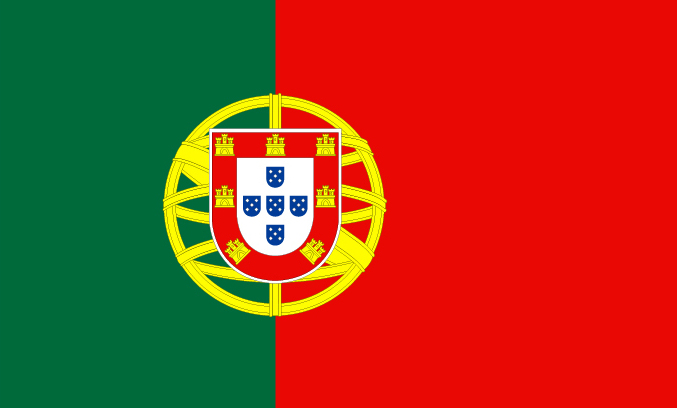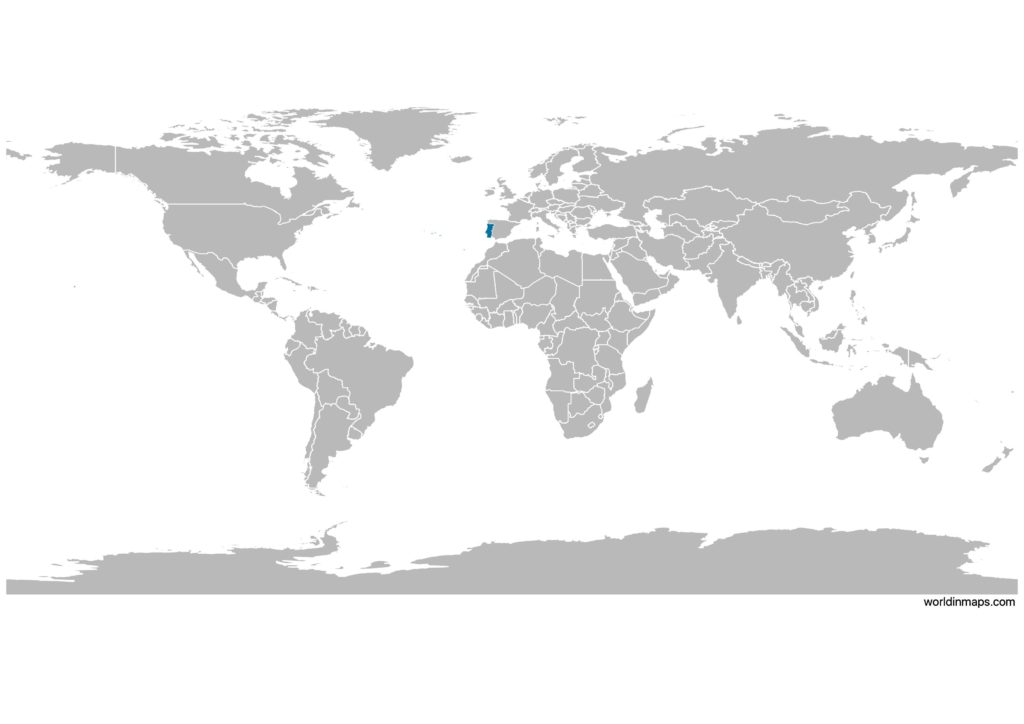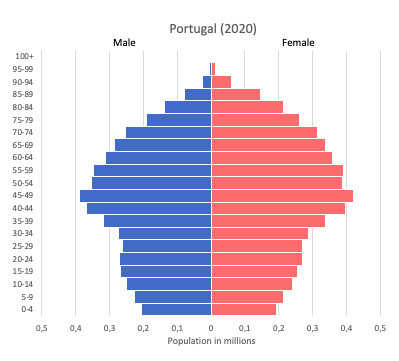Portugal

| Government | |
| Name | Portuguese Republic |
| Portuguese | República Portuguesa |
| Government type | semi-presidential republic |
| Capital | Lisbon (545,245 (2011)) |
| Currency | Euro (EUR) |
| People | |
| Population (2020) | 10,196,707 (90th) |
| Density of population | 114.5 P/km2 |
| Nationality | Portuguese |
| Official languages | |
| Portuguese | |
| Ethnic groups (2018) | |
| Portuguese | 95.3% |
| Others | 4.7% |
| Religions (2011) | |
| Roman Catholic | 81% |
| other Christian | 3.3% |
| other | 0.6% |
| none | 6.8% |
| unspecified | 8.3% |
| Life expectancy (2020) | |
| Male | 77.9 years |
| Female | 84.4 years |
| Total population | 81.1 years (39th) |
| Homicides | |
| Total (2018) | 0.8 per 100,000 people (149th) |
| Geography | |
| Land area | 91,470 km2 |
| water area | 620 km2 |
| total area | 92,090 km2 (112th) |
| Mean elevation | 372 m |
| Lowest point | |
| Atlantic Ocean | 0 m |
| Highest point | |
| Ponta do Pico (Pico or Pico Alto) on Ilha do Pico in the Azores | 2,351 m |
| Land use (2011) | |
| Agricultural land | 39.7% |
| Arable land | 11.9% |
| Permanent crops | 7.8% |
| Permanent pasture | 20% |
| Forest | 37.8% |
| Other | 22.5% |
| Urbanization | |
| Urban population (2020) | 66.3% |
| Rate of urbanization | 0.47% annual rate of change (2015 – 2020) |
| Economy | |
| Labor force (2017) | 5.233 million (80th) |
| Labor force by occupation (2014) | |
| Agriculture | 8.6% |
| Industry | 23.9% |
| Services | 67.5% |
| Unemployment rate (2017) | 8.9% (127th) |
| GDP (PPP) (estimate 2020) | |
| Total | $358.070 billion |
| Per capita | $34,935 |
| GDP (nominal) (estimate 2020) | |
| Total | $243.229 billion |
| Per capita | $23,731 |
| GDP by sector (estimate 2017) | |
| Agriculture | 2.2% |
| Industry | 22.1% |
| Services | 75.7% |
| Exports (2017) | $61 billion (47th) |
| Exports partners (2017) | |
| Spain | 25.2% |
| France | 12.5% |
| Germany | 11.3% |
| UK | 6.6% |
| US | 5.2% |
| Netherlands | 4% |
| Imports (2017) | $74.73 billion (45th) |
| Imports partners (2017) | |
| Spain | 32% |
| Germany | 13.7% |
| France | 7.4% |
| Italy | 5.5% |
| Netherlands | 5.4% |
Portugal on the world map

Portugal is located in Europe and more especially in the Iberian Peninsula.
Portugal top 10 largest cities (2011)
- Lisbon (545,245)
- Sintra (377,249)
- Vila Nova de Gaia (302,092)
- Porto (237,559)
- Loures (205,577)
- Cascais (205,117)
- Braga (181,819)
- Amadora (175,558)
- Matosinhos (174,931)
- Almada (173,298)
Demography
Population pyramid

Age structure data
Estimate for 2020:
- 0-14 years: 13.58% (male 716,102/female 682,582)
- 15-24 years: 10.94% (male 580,074/female 547,122)
- 25-54 years: 41.49% (male 2,109,693/female 2,164,745)
- 55-64 years: 13.08% (male 615,925/female 731,334)
- 65 years and over: 20.92% (male 860,198/female 1,294,899)
Remark: the age structure of a population affects a nation’s key socioeconomic issues. Countries with young populations (high percentage under age 15) need to invest more in schools, while countries with older populations (high percentage ages 65 and over) need to invest more in the health sector. The age structure can also be used to help predict potential political issues. For example, the rapid growth of a young adult population unable to find employment can lead to unrest.
Population from 1950 to 2020
Source: United Nations, Department of Economic and Social Affairs, Population Division (2019). World Population Prospects 2019, Online Edition. Rev. 1.
Evolution of the life expectancy from 1960 to 2018
Source: World Development Indicators, The World Bank
Economy
Agriculture:
grain, potatoes, tomatoes, olives, grapes; sheep, cattle, goats, pigs, poultry, dairy products; fish
Industries:
textiles, clothing, footwear, wood and cork, paper and pulp, chemicals, fuels and lubricants, automobiles and auto parts, base metals, minerals, porcelain and ceramics, glassware, technology, telecommunications; dairy products, wine, other foodstuffs; ship construction and refurbishment; tourism, plastics, financial services, optics
Exports – commodities:
agricultural products, foodstuffs, wine, oil products, chemical products, plastics and rubber, hides, leather, wood and cork, wood pulp and paper, textile materials, clothing, footwear, machinery and tools, base metals
Imports – commodities:
agricultural products, chemical products, vehicles and other transport material, optical and precision instruments, computer accessories and parts, semiconductors and related devices, oil products, base metals, food products, textile materials
Time zone and current time in Portugal
Go to our interactive map to get the current time in Portugal